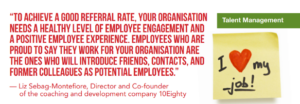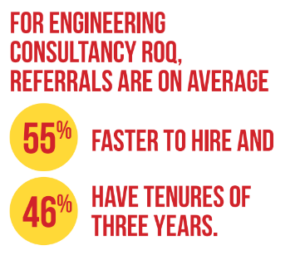An employee referral programme can hire better candidates faster—but there are considerations to ensure success.
By Simon Kent
The ongoing scarcity of skills and talent faced by organisations can, in some instances, can lead HR to search all over for potential employees. However, the answer to the talent challenges can sometimes be closer to home. An organisation’s existing workforce, already fully versed in what working environment has to offer, what the day-to-day entails, and the experience of being an employee, can be a great source for finding potential candidates.
Engineering consultancy Roq runs a dedicated employee referral programme which is open for any permanent role and any permanent employee (with some exceptions). It offers a reward of up to £1,000 per referral for experienced hires, and up to £500 for graduate/apprenticeship hires, dependent on the level of involvement an employee has in the successful recruitment of that individual. The first half of the payment is made on the referral’s start date and the second half upon their successful completion of a probation period.
“In talent attraction, a strong referral or recommendation is very powerful and carries a lot of weight,” says Sean Gray, Roq’s talent acquisition manager.
Among the reasons why referrals work, suggests Gray, is cultural fit and a sense of trust in the new employee. Success plays out in the data too, says Gray, as referrals are on average 55% faster to hire and while making up only 7% of applicants, they deliver 30 to 40% of hires— much higher than any other single applicant source. Referrals also stay for longer: 46% have tenures of three years or more compared to 33% from career sites and 13% from job boards.
Interestingly, Gray believes referrals are particularly good for the more influential roles within the company. “I’d argue that for senior manager roles or leadership roles in particular, referrals are particularly important and advantageous,” he says, noting that their senior sales team has been predominantly built via referrals. “It can take a considerable amount of time, effort, and resources to fulfil a senior manager role so you need to ensure your hire is the right one the first time,” he explains.
“Additionally, when someone in a senior manager role joins your company, they immediately have considerable impact and influence on your business, compared with a junior or mid-level role, through their remit, the teams they manage, the departments they’re driving, their engagement with clients, and third parties.”
Gray says a referral practically pre-qualifies the candidate in these areas, because the referrer will likely have worked with them in some capacity, knows how they operate, and knows that they align to their company’s ways of working.
At HR software provider Ciphr, £1,500 is on offer for every referral placement, with the payment spread over six months and linked to the successful completion of a probation period.
But as Claire Williams, chief people and operations officer at Ciphr points out, referrals are not without their complications and strategies need to be well-designed and structured to be effective.
Among the areas Williams says should be considered are the impact of referrals on diversity, the need for clear communication throughout, and documented processes which avoid confusion about payments. The approach must ensure any suggestion of favouritism is ruled out. “Organisations also need to ensure that their employee referrers, who put forward potential candidates, are aware of and comfortable with any impact on their relationship if their ‘friend’ is unsuccessful at the recruitment stage or is subsequently exited from the business due to performance or conduct issues,” she says. “The reality is that these things don’t always work out, and the worst-case scenario is that you end up losing good talent because an employee is annoyed that you fired their friend or family member.”
Liz Sebag-Montefiore, director and co-founder of the coaching and development company 10Eighty, agrees that there is a delicate balance to ensure referral programmes work well. Her tips include keeping things simple and making sure there is a prompt response whenever a person is referred. Echoing Williams’ note of caution, the last thing that should happen with an employee referral is that an existing member of staff becomes annoyed or demotivated. The recruitment experience is often touted as a gateway experience to a business’ brand and reputation and getting things wrong around a referral can create more negative feelings than a straight-forward interview and decline. 
While acknowledging financial incentives are good for referrals—especially in the current climate— Sebag-Montefiore believes other incentives, such as charitable contributions, are also effective, dependent on company culture and individual preference.
“HR is best situated to judge whether such a scheme is appropriate and likely to prove effective,” says Sebag-Montefiore. “To achieve a good referral rate, your organisation needs a healthy level of employee engagement and a positive employee experience. Employees who are proud to say they work for your organisation are the ones who will introduce friends, contacts, and former colleagues as potential employees. Conversely, if the organisation has a poor employer brand, then employees won’t refer contacts they value.”
Sebag-Montefiore highlights the financial savings referrals can deliver on—like reducing agency and advertising fees. Also, if handled properly, these schemes can have wider positive impacts on a company’s culture and future as employees feel they are valued and trusted.
At the same time, however, referrals can also lead to a decrease in diversity amongst candidates which, while unintentional, is a drawback. “Beware of favouritism and nepotism hires which may breed discontent and resentment,” advises Sebag-Montefiore.
She also notes that referral schemes can extend beyond current employees. Alumni, contractors, suppliers, customers, and other stakeholders can have a good relationship with the organisation and be in an ideal situation to make useful suggestions. And, of course, social media can also be utilised to spread the word further among interested parties. With a bit of imagination and care, all these techniques can help put HR in touch with someone who knows someone who can.














